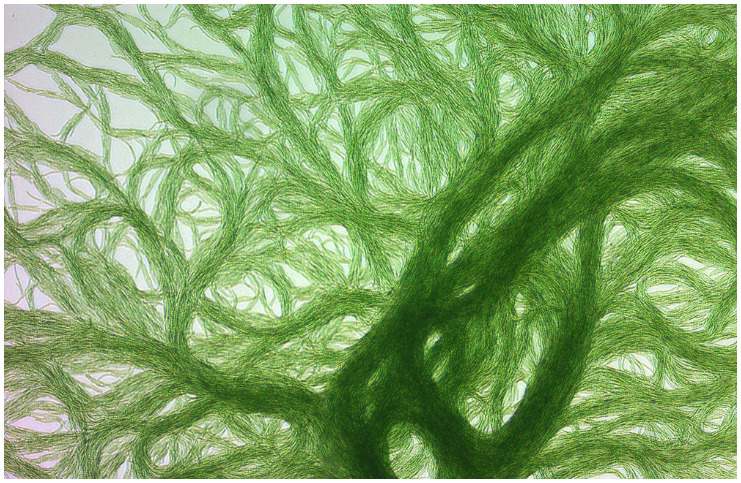Blue-Green Algae (Cyanophyta) – Facts, Uses, Health Benefits, Side Effects:
Blue-green algae is a microscopic, unicellular, and filamentous plant, isolated or reunited into colonies. They have a varied cellular shape: oval, spherical, ellipsoid, or cylindrical.
The cell is bounded by a membrane. It is also known as “cyanobacteria,” and this name comes from the color of the bacteria (blue in Greek).
Facts
They have autotrophic nutrition. Under certain conditions, some of them can become saprophytes (they provide themselves nutrition on account of lifeless organic matter degradation, vegetal or animal origin).
Most blue-green algae do not grow in the absence of light, nevertheless, a few can grow in the dark if there is enough supply of glucose to act as an energy source and a carbon.
They appeared in the Precambrian and live in moist soil and the aquatic environment. They contain just one type of chlorophyll, namely – chlorophyll a, which is a green pigment.
The composition of algae consists of trace elements in appreciable quantities: iodine (some algae contain more iodine than seawater), bromine (less than seawater), magnesium, potassium, sodium, calcium, phosphorus, sulfur, chlorine, copper, and silicon; vitamins A, B1, B2, B6, B12, C, D, E, K, PP; amino acids (methionine, serine, glutamic acid, cysteine), carbohydrates, chlorophyll, antibiotic substances, cellulose, etc.
Due to all these components, the algae have the following properties: stimulation of the endocrine glands and the body’s natural defense system, stimulation of the blood circulation, anti-rheumatic, anti-infectious, etc.
Uses of Cyanobacteria
As food, powder, or tablets, algae have always been consumed by their protein richness, trace elements, and vitamins by Eastern and Far Eastern nations, as well as some northern populations. Chinese and Japanese use them today for their aphrodisiac properties and against early aging.
In Scotland and Ireland, algae are used in bread manufacture, and in Japan, they are included in the composition of pastries, jams, etc.
For external use, algae are used either as extracts or are incorporated in various creams and powerful serums. Many cosmetic companies prefer to use them with purified seawater, others would mix other natural products with a high content of minerals, such as clay.
Used in cleansing products, alginates from algae remove dirt, makeup, excess sebum, and other impurities. Algae extracts help close pores, tone the skin, support the anti-inflammatory effect, help reduce blemishes, irritation, and blackheads, alleviate acne, and balance sebum secretion.
Incorporating microscopic algae can generate a slightly abrasive action on the skin surface and is successfully used in masks and exfoliating creams for the face, body, hands, and heels. Algae baths are recommended for the body’s skin regeneration, used fresh or dried and rehydrated in water.
In specialized beauty salons, algae baths are used in combination with marine mud, and at home, the treatment continues as local cataplasms with fresh algae, warm or heated with infrared or microwaves, cataplasms with algae mixed with marine mud, or simply an algae paste (obtained from chopped dried algae).
Health benefits of blue-green algae (Cyanophyta)
Remedy for fatigue
They are useful for physical and mental fatigue, glandular disorders, nervous disorders, demineralization, anemia, convalescence, senescence, menopausal disorders, arthrosis, rheumatoid polyarthritis, ankylosing spondylitis, neuralgia, myalgia, obesity, cellulite, atherosclerosis, chronic nasopharyngitis, constipation, acne, or eczema.
Improves vision
This type of algae is approximately 70 percent vegetable protein and also has higher levels of beta-carotene. Beta-carotene is the most prevalent carotenoid in the plant sources of the food chain and is known as pro-vitamin A.
Due to the fact that vitamin A helps protect the surface of the eye, it is an important nutrient, particularly for good vision. Moreover, beta-carotene is a strong antioxidant, offering benefits to the lungs and the immune system.
An excellent protein source
Two varieties, Aphanizomenon flos-aquae, and spirulina, are the most consumed types of Cyanobacteria, especially spirulina has superfood status due to high concentrations of vitamins, proteins, and nutrients.
Spirulina also has many phytonutrients, enzymes, and cofactors so that your physical body can actually absorb minerals, vitamins, and protein.
As a side note, spirulina was consumed by the Aztecs, plus, it became popular when NASA hinted that spirulina could be grown in space and used by astronauts.
Good for type 2 diabetics
Type 2 diabetes is a chronic blood glucose disorder, and it is commonly associated with being overweight.
It usually develops in middle-aged and older adults, nevertheless, recently, it is more frequent in children and teens. According to some studies, consuming spirulina lowers glycemic levels in patients with Type 2 Diabetes Mellitus.
Seasonal Allergies
According to studies, taking two grams a day of blue-green algae by mouth for 180 days might relieve allergy symptoms in adults.
Side Effects of Blue-Green Algae
Contaminated blue-green algae may contain microcystins (a class of toxins) that can cause:
- fast heartbeat;
- vomiting;
- nausea;
- stomach pain;
- liver damage.
READ THIS NEXT:
Wasabi: Health Benefits, Nutrition Facts, Side Effects
Morel Mushrooms – Health Benefits
Gotu Kola: Side Effects, Health Benefits, Uses
References https://www.researchgate.net/publication/242477158_Taxonomic_study https://www.ncbi.nlm.nih.gov/pubmed/19191979
